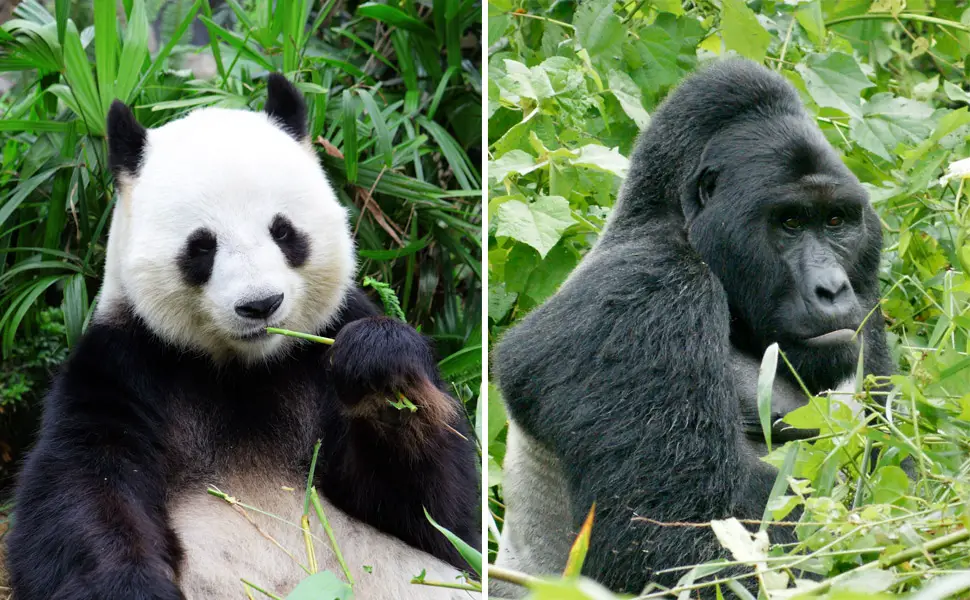
6th September 2016 Latest update of threatened species list brings good and bad news The IUCN has removed the giant panda from its endangered species list, but added the eastern gorilla to its critically endangered list.
The World Conservation Congress, which convenes every four years, is currently being held in Hawaii, USA. The International Union for Conservation of Nature and Natural Resources (IUCN), which organises the meetings, has just released an update to its "Red List" of species threatened with extinction. This brings some good news, but also a number of worrying developments. On the plus side, the Giant Panda (Ailuropoda melanoleuca) has now been moved from "Endangered" to "Vulnerable", following decades of efforts to protect and restore the forests on which the animals depend. Their increased population and improved status confirms that the Chinese government's policies are effective. However, climate change is predicted to eliminate more than 35% of the Panda's bamboo habitat later this century and could therefore reverse the gains made since the 1990s. To protect this iconic species, the IUCN emphasises it is critical that the effective forest protection measures are continued and that newly emerging threats are fully addressed. The Chinese government is planning to expand its existing conservation policy for the species, which the IUCN says must be strongly supported to ensure its effective implementation.
From left to right: Extinct (EX), Extinct in the wild (EW), Critically endangered (CR), Endangered (EN), Vulnerable (VU), Near threatened (NT), Least concern (LC).
Although the news is encouraging for giant pandas, other species are facing much greater challenges. The Eastern Gorilla – the largest living primate – has been moved from "Endangered" to "Critically Endangered" due to a devastating population decline of more than 70% in 20 years. Its population is now thought to be fewer than 5,000. Grauer's Gorilla (G. b. graueri), one of the two subspecies, has lost 77% of its population since 1994, declining from 16,900 individuals to only 3,800. Killing or capture of great apes is illegal; yet hunting represents the greatest threat to Grauer's Gorillas. The second of the species, the Mountain Gorilla (G. b. beringei), has been faring better, increasing in number to around 880 individuals. Four of the six great apes – the Eastern Gorilla, Western Gorilla, Bornean Orangutan and Sumatran Orangutan – are now listed as Critically Endangered, whilst the Chimpanzee and Bonobo are listed as Endangered. "To see the Eastern Gorilla – one of our closest cousins – slide towards extinction is truly distressing," said Inger Andersen, the IUCN Director General. "We live in a time of tremendous change and each IUCN Red List update makes us realise just how quickly the global extinction crisis is escalating. Conservation action does work and we have increasing evidence of it. It is our responsibility to enhance our efforts to turn the tide and protect the future of our planet."
The latest Red List includes almost 83,000 species of animals and plants, of which nearly 24,000 are threatened with extinction. The IUCN, its Species Survival Commission and nine partner institutions will jointly commit more than US$10 million, as part of an ambitious strategic plan that aims to double the number of species assessed on the Red List by the year 2020. "The world is changing fast and dramatically," said Dr M Sanjayan, senior scientist from Conservation International. "Now more than ever, amid the updates to the Red List, it's crucial to identify and track the elements of nature that need protection the most. Monitoring the diversity of life is a fundamental part of all our efforts to understand the changes happening on our planet and focusing our conservation efforts so that people and nature can thrive." "Illegal hunting and habitat loss are still major threats driving many mammal species towards extinction," said Carlo Rondinini, Coordinator of the mammal assessment at Sapienza University of Rome. "We have now reassessed nearly half of all mammals. While there are some successes to celebrate, this new data must act as a beacon to guide the conservation of those species which continue to be under threat." ---
Comments »
|









